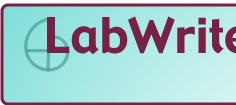| LabWrite
provides a lot of resources to help you write lab reports and learn science.
In addition to the PreLab, InLab, PostLab, and LabCheck of the standard
laboratory, LabWrite also includes certain special features that you might
not notice right away. Some of these are guides for doing other kinds
of labs besides the standard lab. But there are also some other features
you could use more generally to help you with any labs. Here’s a
list of some of these special features with links to descriptions.
Descriptive
Labs
Designing Your Own Lab Experiments
Partial Lab Reports
Graphing Resources
Writing Resources
Sample Student Lab Reports
Descriptive
labs
The default lab report in LabWrite
is the hypothetical, or standard, lab, based on establishing and testing
a hypothesis. However, there are some labs that don’t lend themselves
to making hypotheses. We call these descriptive labs: the emphasis is
more on following a lab procedure and describing what you observe. You
could be doing a lab that focuses on learning new lab techniques, determining
an unknown, collecting observations on specimens, etc. When you do a descriptive
lab, instead of establishing a hypothesis, LabWrite directs you to ask
questions about the lab in the Introduction and to return to those questions
in the Discussion.
LabWrite provides the entire
sequence of stages for descriptive labs, PreLab, InLab, PostLab, and LabCheck.
These guides can be found on the home pages for each LabWrite stage.
Designing Your Own Lab Experiments
Scientists generate hypotheses
and design experiments to test their hypotheses. Your lab instructor may
allow you to do the same thing in a lab. Instead of following an established
procedure given in your lab manual, you will be given a scientific problem
and will be able to design your own way of solving the problem. LabWrite
provides a guide you can use for designing your own experiments. It starts
out by leading you through the kind of thinking scientists do when they
are trying to solve scientific problems: defining the problem, asking
a research question, identifying the experimental variables, establishing
a hypothesis, and creating an experiment to test the hypothesis. That’s
the PreLab. There’s also an InLab, PostLab, and LabCheck specifically
for labs that you design.
You can find the guides to
Designing Your Own Lab Experiments on the home pages for each of the LabWrite
stages--PreLab, InLab, PostLab, LabCheck.
Partial Lab Reports
Some lab instructors ask their
students to write parts of a lab report instead of a complete report.
For instance, students may do the Results section in the first lab and
Methods and Results in the second lab and so on until they build up to
a complete lab report. LabWrite offers a guide to writing lab reports
in this way, too.
The key to the LabWrite approach
to partial reports, though, is that you write a one-sentence summary of
the parts of the report that you are not asked to write in full. This
helps you develop a good understanding of the scientific logic of the
whole lab report even if you are asked to write only a partial report.
See Guide to Writing Partial
Lab Reports on the PostLab Homepage.
Graphing Resources
In most labs, instructors expect
you to be able to create a spreadsheet and enter data in it, to determine
whether or not your lab data should be presented as a table or as a graph,
to figure out what kind of graph is most appropriate for your data, to
use error bars, etc. In other words, you are expected to know how to record
and present data like an experienced scientist.
LabWrite provides extensive
help for you if you’re not quite sure how to do all that. Check
out these student guides at Graphing Resources. You will also be directed
to the help you need when you need it in the InLab and PostLab stages.
Writing Resources
LabWrite also provides a set
of resources to help you with your writing. You need help with grammar?
You need help with proper citations and references? You want easy access
to the LabWrite Checklist and Evaluation Guide? You want to refer to a
Quick Guide to PostLab Stages? You can find all this and more at Writing
Resources.
Sample
Lab Reports
Sometimes it’s helpful
to be able to see what a good lab report looks like. This is especially
true if this is your first class in which you are assigned full lab reports.
LabWrite makes a variety of sample reports available, each one presented
in a straight version and in an annotated version, which shows you how
the step-by-step instruction in the LabWrite PostLab guide has been applied
to a completed lab report.
There are lab reports from
a variety of fields. There are both hypothetical and descriptive reports
and reports using quantitative and qualitative data. You can find Sample
Lab Reports under Additional Resources in the Resources Home Page.
|




